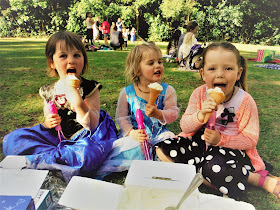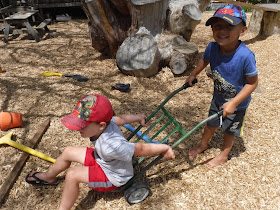As the festive season
comes round we start to think about all the wonderful things we are grateful
for (among all the Christmas rush and chaos). We have been busy at kindergarten
engaging in different festive rituals. This has included making many
decorations for our Christmas Tree which is on display at the St. John Church on
Kamo Road. This is a lovely community event that we have been involved in for
the past three years. The children spend time making different decorations and
then the teachers take them to the church, decorate the tree and plan a walk so
that our children can see their lovely Christmas tree amongst many others.
Being a part of this special event brings with it so many lovely warm feelings
of gratitude and joy. As we plan our walk to the local church and count down
the days in anticipation, the children also practice singing Christmas carols.
They practice so that they can respond and thank our hosts at the church. It is
always beautiful and heart-warming hearing our children sing and we love that
they want to share their passion for singing with others.
Organising the excursion
and being out in community is another area that is so special. We have such
wonderful family support and this walk was once again proof of how awesome our
families are. We needed 6 helpers to make this trip viable, instead we had 22
helpers come along! It is so good for the soul to see everyone come together
and make our kindergarten events so special. Because of this our walk was very
successful (and so it should be with nearly 70 of us walking the streets of
Kensington!) We were very proud of how the children behaved and represented our
kindergarten out in community and very pleased that everyone had such a lovely
morning.
One of our other rituals we have started to
celebrate our festive season has been creating a gratitude tree. This started
last year and I wrote blog post about it which you can read here. We invite families to write something that they are
grateful for in regards to having their child in their lives and then this is
hung on our special kindergarten Christmas tree for all to see. The gratitude
tree becomes a beautiful addition to our kindergarten environment and it is so
lovely to stop at and have a read of all the lovely words that are written
about our children. One of the most special happening that take place around
the gratitude tree is when children have their cards read to them and they just
beam with happiness.
"Gratitude means thankfulness, counting your blessings, noticing simple pleasures, and acknowledging everything that you receive. It means learning to live your life as if everything were a miracle, and being aware on a continuous basis of how much you’ve been given. Gratitude shifts your focus from what your life lacks to the abundance that is already present. In addition, behavioral and psychological research has shown the surprising life improvements that can stem from the practice of gratitude. Giving thanks makes people happier and more resilient, it strengthens relationships, it improves health, and it reduces stress." (Marelisa Fabrega)
Lastly, another ritual we
have is our end of year celebration at Mair Park where our families are invited
to join us for a picnic dinner followed by a visit from a special guest (this
year it was Santa himself) and a fun treasure hunt for chocolate money. Once
again this year it was so lovely to see so many families relaxing and getting
to know one another a little better. The children were all having such a great
time playing games with one another and enjoying each other’s company outside
of kindergarten. This is a great example of why we love to foster and celebrate
creating meaningful relationships amongst everyone who is a part of our kindergarten
community. The benefits from these relationships are so special and help make
Mairtown Kindergarten what it is.
I would also like to take this opportunity to
share how I am so grateful for everything that Mairtown Kindergarten brings to
my life. After being a part of the Mairtown Kindergarten community for
the past six years I have been lucky enough to work with so many wonderful
families and an amazing team of teachers. When reflecting on this it makes me realise
that Mairtown Kindergarten is not just a place that I go and work at, it is a
place that brings me so much joy and delight and it is a place that makes me
incredibly happy and fulfilled. I am so thankful that I am a part of this
special place and all that it brings to my life.
On behalf of the Mairtown
team I would like to say a huge thank you to our incredible families at
kindergarten and all that you do and bring to our community, you make it a
beautiful place. Have a safe and happy summer break. For those how are heading
off to school next year we wish you well on your next journey and for those who
are returning, we look forward to seeing you refreshed in term 1 2017.
“Each day brings new opportunities, allowing you
to constantly live with love—be there for others—bring a little light into
someone's day. Be grateful and live each day to the fullest.” (Roy T. Bennett)
Kindest regards
Zair







































































